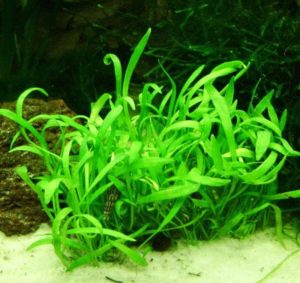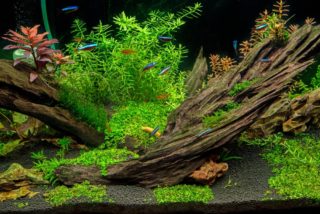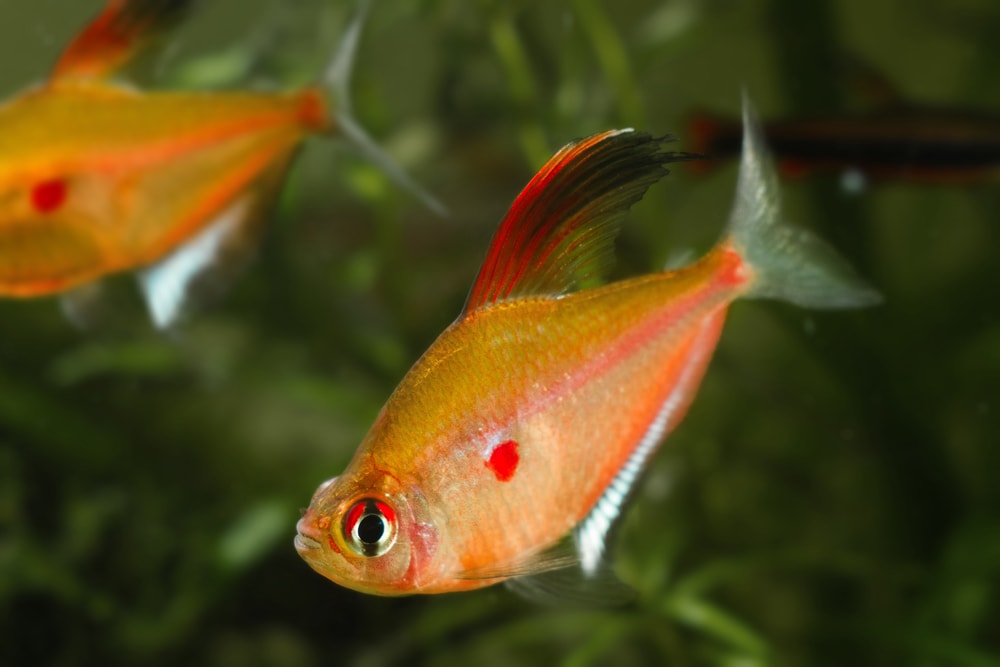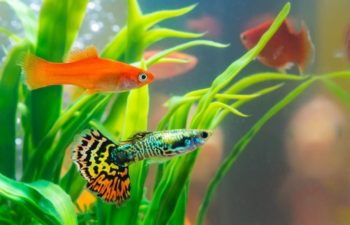10 Best Aquarium Plants for the Foreground in 2024: Reviews & Top Picks

Updated on

We’ve chosen ten of the most popular and attractive foreground plants to review for you to help you learn more about them. We’ll go over the pros and cons of growing each type and tell you about any accessories they require. We’ve also included short buyers guide where we discuss what makes a good foreground plant and how to choose one for your aquarium.
Join us while we discuss growing height, CO2, lighting, and much more to help you choose the perfect aquarium plant for the foreground.
A Quick Comparison of Our Favorites in 2024
| Rating | Image | Product | Details | |
|---|---|---|---|---|

|
Micro Sword Aquarium Live Plant |
|
Check Price | |

|
Staurogyne Repens |
|
Check Price | |

|
Marimo Moss Ball |
|
Check Price | |

|
Mainam Dwarf Lobelia Cardinalis |
|
Check Price | |

|
Hygrophila Corymbosa Siamensis |
|
Check Price |
The 10 Best Aquarium Plants for the Foreground
1. Micro Sword Aquarium Live Plant
- Growth rate: Fast
- Max height: 4-6 inches
- Light demands: Low
- CO2: Low
- Difficulty: Easy
The Micro Sword Aquarium is at the top of our list because it’s easy to grow, and most beginners should be successful in adding it to their tank. It grows quickly and is satisfying to watch while providing a fantastic natural hiding place for many fish species. It can get up to 6 inches tall but usually hovers around four, so it’s perfect for your aquarium’s foreground, and it doesn’t require any special lighting or CO2 tanks to keep it alive. However, adding them will increase the growth rate and maximum height.
The downside to adding the Micro Sword is that it can be difficult to get rooted. The roots are very small and delicate, and they take a while to latch on, so they often float to the surface, and you’ll need to try again. We felt the portion size could be a little bigger, and ours had many snails, which could be a big problem in some tanks.
- Fast-growing
- It does not require CO2
- Provides natural hiding place
- Low maintenance
- Hard to keep rooted
- Snails
- Small portion
2. Staurogyne Repens
- Growth rate: Medium
- Max height: 1-4 inches
- Light demands: Low
- CO2: Low
- Difficulty: Easy
Staurogyne Repens is just as easy to grow as our top choice and is a perfect choice for beginners. It grows a little slower, so it’s not as immediately gratifying. However, it spreads nicely, and you can use it to create an attractive carpet on the bottom of your tank. Its texture provides contrast and a hiding place for your shy fish. It doesn’t require and additional CO2 or lighting but will grow better if you supply it.
The only problem we had with Staurogyne Repens was that the portion we got had grown tightly together, and we couldn’t break it apart without damaging it, so we didn’t get as much initial coverage as we were expecting.
- It doesn’t require lighting
- It doesn’t require CO2
- Easy to grow
- Delicate roots
3. Marimo Moss Ball
- Growth rate: Slow
- Max height: 1-4 inches
- Light demands: Low
- CO2: Low
- Difficulty: Easy
The Marimo Moss Ball is an attractive plant that resembles a large cotton ball. In Japan, it is a national treasure and a symbol of love and everlasting friendship. It’s easy to maintain and fun because you need to turn over the balls daily to keep the round shape, but it doesn’t require any extra lighting or CO2. We also liked that you don’t plant it, so there is no fussing over keeping it in place.
The downside to the Marimo Moss Ball is that it grows incredibly slowly and may look the same for several months. Larger Marimos can be as large as a softball but take 200 years to get there. Our portion of three Marimo Moss Balls is small and serve as purely ornamental, so it’s not something you can use to create a carpet or provide shelter for shy fish. It’s also one of the more expensive aquarium plants since many others will grow to cover the entire floor of your tank.
- Easy to maintain
- No planting
- It doesn’t require lighting
- It doesn’t require CO2
- Don’t cover much of the area
- Very slow growing
- Expensive
4. Mainam Dwarf Lobelia Cardinalis
- Growth rate: Medium
- Max height: 8-12 inches
- Light demands: Medium
- CO2: Low
- Difficulty: Easy
Mainam Dwarf Lobelia Cardinalis is an easy to grow plant with green and purple leaves that are attractive and add contrast to your aquarium. It can grow to be as tall as 8-12 inches in the proper environment, so it provides fantastic cover for your fish if they’re shy or feeling stressed. It doesn’t require any CO2 tanks but will grow better if you have one.
The downside to adding Mainam Dwarf Lobelia Cardinalis to your tank is that they are very delicate, especially at first, and can be difficult to plant. We found it better to allow them to float or keep them loosely tied to some driftwood for several weeks. You can try to replant at that time or leave them be. You will also need some full-spectrum light for maximum growth and color, with improper lighting resulting in only green plants. Another problem we had was that several of the plants arrived damaged because they are too delicate for transport, so you might want to pick up yours at the local pet store.
- Easy to grow
- It doesn’t require CO2
- Multicolor
- Easy to damage when planted
- Hard to ship
5. Hygrophila Corymbosa Siamensis
- Growth rate: Fast
- Max height: 4-8 inches
- Light demands: Medium
- CO2: Medium
- Difficulty: Medium
Hygrophila Corymbosa Siamensis is a fast-growing plant with large leaves that provides plenty of hiding places for your fish while being attractive to look at from the outside. It grows quickly, usually to about five or six inches high, and will spread out if left alone. It will attach to driftwood, or you can plant it in a nutritious substrate for faster growth. We received a large portion in the mail and were able to get many of the plants growing.
For Hygrophila Corymbosa Siamensis to thrive, you will need to supply CO2 along with plenty of full-spectrum lighting. It’s better for people who have some experience growing. The plants are also very delicate, and several of ours arrived damaged.
- Fast-growing
- Spreading
- Large portion
- Provides shelter
- Slow to catch on
- Shipping damage
- Requires lighting and CO2
6. Downoi
- Growth rate: Medium
- Max height: 1-4 inches
- Light demands: Medium
- CO2: Medium
- Difficulty: Medium
Many people shorten the name Downoi to “Down,” and it’s a short plant often used as an aquarium carpet. It has creased leaves that grow quickly and provide plenty of contrast. You can plant off-shoots as they appear to grow new plants, which will form a unique carpet in no time, and you get a nice portion of mostly good plants.
The downside to Downoi is that it can be sensitive to the amount of light and CO2 in the water. It’s easy to maintain but will not grow and produce off-shoots if the levels are off. We also found that several of the plants in our portion didn’t take and eventually died. Luckily, we had enough that they were able to recover.
- Fast-growing
- Spreading
- Good portion
- Requires lighting and CO2
- It doesn’t always take
7. Water Plants Ranunculus Inundatus – River Buttercup
- Growth rate: Medium – High
- Max height: 2-4 inches
- Light demands: Medium
- CO2: Medium
- Difficulty: Medium
Water Plants Ranunculus Inundatus is also called River Buttercup and is often found in muddy soil around river beds in many parts of the world. It’s a creeping plant that uses runners to propagate and cover the aquarium’s bottom if you allow it. The attractive leaves are forked and resemble stars. It provides a great hiding place for nervous fish and usually only gets about 3 inches tall, so it’s perfect for the foreground.
River Buttercup’s downside is that it can be difficult to plant at first, and ours kept floating to the surface. It will also require CO2 and as much light as you can put on it if you want it to grow quickly. Reducing light will slow or halt growth. The last problem we had was that even though it will spread quickly, it’s quite expensive compared to several other plants on this list.
- Creeping
- Attractive leaves
- Expensive
- Requires lighting and CO2
- Hard to plant
8. Mainam Riccia Fluitans Crytalwort Live
- Growth rate: Medium
- Max height: 1-2 inches
- Light demands: Medium
- CO2: Medium
- Difficulty: Medium
Mainam Riccia Fluitans Crytalwort Live, often shortened to Crytalwort, is a type of floating plant that you can also tie to some driftwood or lava rock to keep it in place underwater. It stays short and only gets about 2 inches tall, making it an ideal foreground plant for your aquarium.
Crytalwort will require CO2 and Lighting to grow correctly and stay healthy, especially when placed underwater, and it can be challenging to get the correct levels for optimal health. We also damaged several plants as we tried to remove the gel on the roots.
- Large portion
- Floating or tied
- Perfect for foreground
- Requires CO2 and lighting
- The gel is difficult to remove
9. Alternanthera Reinecki
- Growth rate: Medium
- Max height: 3-12 inches
- Light demands: Medium
- CO2: Medium
- Difficulty: Medium – Advanced
Alternanthera Reinecki is a plant that you can find in several varieties that range in size and color. The variety we are talking about is 3 to 12 inches tall, with most about 8 inches. It’s an attractive flowering plant that provides ample cover for nervous fish.
Unfortunately, Alternanthera Reinecki is one of the more difficult plants to grow successfully. It requires medium to high light and CO2 levels, and it isn’t easy to get planted. Ours kept floating to the surface. Shipping is another problem for these delicate plants, and many of them arrived dead or damaged.
- Flowering
- Large portion
- Healthy plants
- Too delicate for shipping
- Hard to plant
10. Pearlweed Plants
- Growth rate: Medium
- Max height: 2-6 inches
- Light demands: Medium
- CO2: Medium
- Difficulty: Advanced
The Pearlweed plant is the last on our list because it’s the only one that requires an advanced skill set. We recommend it only for aquariums with experienced owners. It comes in a large portion, and when properly maintained, it grows to about four inches and will quickly spread, creating a carpet for your aquarium.
The downside to Pearlweed is that it requires plenty of light and CO2. It will also require nutrients in the substrate. It can be challenging to plant because it tends to float to the surface, and the gel it’s packaged in is difficult to wash off. If not careful, you can easily damage the plants removing the gel, and if you have fish and they eat it, it can cause health issues
- Large portion
- Quickly spreads
- Requires nutrients
- Gel
- Hard to plant
- Requires CO2 and Light
Buyer’s Guide: How to Pick the Best Aquarium Plants for the Foreground
Let’s take a look at some things to consider when choosing a foreground plant.
Lighting
Lighting is an important part of your aquarium and can be confusing to many beginners. Without adequate lighting, your plants won’t grow, and your fish won’t be healthy. Most fish prefer bright light, but several varieties prefer shade. You will need to match your plants and you’re lighting to the kind of fish you have.
There are three types of lights: incandescent, fluorescent, and LED. These choices can confuse many people, but the only type we would avoid is incandescent lights because they will heat the water unevenly and unpredictably depending on how strong they are and how long you leave them on. We recommend LED aquarium systems because they are inexpensive, long-lasting, and don’t produce any heat.
CO2
Another important part of any aquarium containing live plants is carbon dioxide gas (CO2). Plants require it to thrive but adding too much can be deadly to the fish. If you are inexperienced with CO2 or have expensive fish, we recommend beginning with varieties that don’t require much CO2 to grow. As you gain experience and know-how to tell if your fish is suffering from carbon dioxide poisoning, you can move on to harder plants.
CO2 systems are a bit more expensive than an LED lighting system, but they often come with everything you need and contain step-by-step instructions to get you started quickly.
Helpful Tips
- Start by dividing your plant portion into small bunches that you can hold with tweezers and place them on a tray so you can retrieve them quickly.
- Start planting by attaching the plants to the side of driftwood or lava stones to help them get started.
- If you need to plant into the substrate, remove the water until it is barely submerged, then use tweezers to place the plants carefully.
- Consider how large the plant will be full-grown when spacing them out to cover the most area with the least number of plants.

Conclusion
We hope you have enjoyed our reviews of these amazing plants and have found the answers you were after. If you’re inexperienced, we recommend starting with the plants near the top of our list. The Micro Sword Aquarium plant is very easy to grow and doesn’t require any additional lighting or CO2. It is also attractive and grows to the perfect height for the foreground of most aquariums. Another great choice is the Marimo Moss Ball. It also doesn’t require any lighting or CO2 and is attractive even on its own.
If we have helped you find your next addition, please share these ten aquarium plants for the foreground on Facebook and Twitter.























